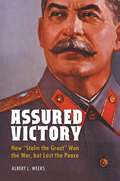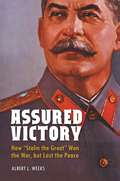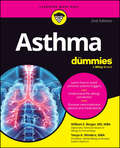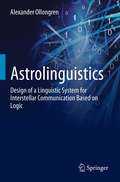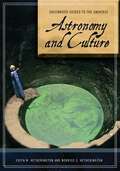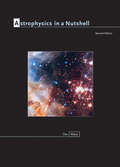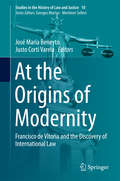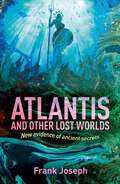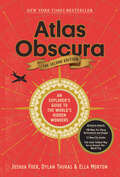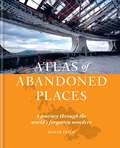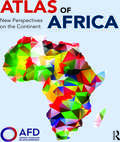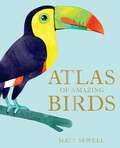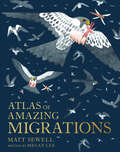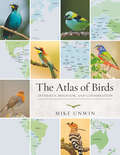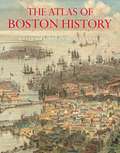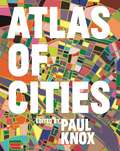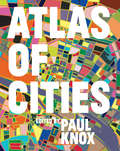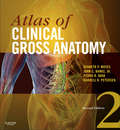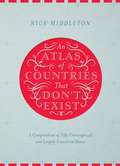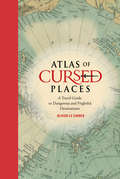- Table View
- List View
Assured Victory: How "Stalin the Great" Won the War, but Lost the Peace
by Albert L. WeeksThis book documents dictator Joseph Stalin's brilliant tactics as well as missteps in taking preemptive actions that guaranteed ultimate victory over the German invaders. It also covers the policies implemented after the war that made the Soviet Union a menace to world peace and led to collapse of Soviet rule.A detailed reexamination of historical facts indicates that Stalin could deserve to be regarded as a "great leader." Yet Stalin clearly failed as his nation's leader in a post-World War II milieu, where he delivered the Cold War instead of rapid progress and global cooperation. It is the proof of both Stalin's brilliance and blunders that makes him such a fascinating figure in modern history.Today, most of the Russian population acknowledges that Stalin achieved "greatness." The Soviet dictator's honored place in history is largely due to Stalin successfully attending to the Soviet Union's defense needs in the 1930s and 1940s, and leading the USSR to victory in the war on the Eastern Front against Nazi Germany and its allies. This book provides an overdue critical investigation of how the Soviet leader's domestic and foreign policies actually helped produce this victory, and above all, how Stalin's timely support of a wartime alliance with the Western capitalist democracies assured the defeat of the Axis powers in 1945.
Assured Victory: How "Stalin the Great" Won the War, but Lost the Peace
by Albert L. WeeksThis book documents dictator Joseph Stalin's brilliant tactics as well as missteps in taking preemptive actions that guaranteed ultimate victory over the German invaders. It also covers the policies implemented after the war that made the Soviet Union a menace to world peace and led to collapse of Soviet rule.A detailed reexamination of historical facts indicates that Stalin could deserve to be regarded as a "great leader." Yet Stalin clearly failed as his nation's leader in a post-World War II milieu, where he delivered the Cold War instead of rapid progress and global cooperation. It is the proof of both Stalin's brilliance and blunders that makes him such a fascinating figure in modern history.Today, most of the Russian population acknowledges that Stalin achieved "greatness." The Soviet dictator's honored place in history is largely due to Stalin successfully attending to the Soviet Union's defense needs in the 1930s and 1940s, and leading the USSR to victory in the war on the Eastern Front against Nazi Germany and its allies. This book provides an overdue critical investigation of how the Soviet leader's domestic and foreign policies actually helped produce this victory, and above all, how Stalin's timely support of a wartime alliance with the Western capitalist democracies assured the defeat of the Axis powers in 1945.
Asthma For Dummies
by William E. Berger Tonya A. WindersBreathe easier and live a full life with proper asthma treatment Asthma For Dummies is a reassuring and realistic guide to managing asthma, whether you’re living with it yourself or have a loved one who suffers from the disease. It’s packed with authoritative information on symptoms and diagnosis, plus resources you can use to enhance long-term asthma management. Find the best treatments and reduce asthma complications with compassionate advice and all the latest details on medication options, including asthma controller drugs, rescue asthma medications, and future trends in asthma therapy. Discover the most common triggers and suggestions for avoiding them in daily life. With the expert advice in this Dummies guide, you can tackle asthma. Learn all the basics about diagnosing and managing asthma in adults and children Find out about the newest treatments, therapies, and alternative strategies Prepare for your doctor’s appointment with questions to ask and ideas for working through financial concerns Know what to do about complications, dual diagnoses, and special circumstancesThis updated edition of Asthma For Dummies is a must-have for asthmatics and parents of asthmatic children.
Asthma For Dummies
by William E. Berger Tonya A. WindersBreathe easier and live a full life with proper asthma treatment Asthma For Dummies is a reassuring and realistic guide to managing asthma, whether you’re living with it yourself or have a loved one who suffers from the disease. It’s packed with authoritative information on symptoms and diagnosis, plus resources you can use to enhance long-term asthma management. Find the best treatments and reduce asthma complications with compassionate advice and all the latest details on medication options, including asthma controller drugs, rescue asthma medications, and future trends in asthma therapy. Discover the most common triggers and suggestions for avoiding them in daily life. With the expert advice in this Dummies guide, you can tackle asthma. Learn all the basics about diagnosing and managing asthma in adults and children Find out about the newest treatments, therapies, and alternative strategies Prepare for your doctor’s appointment with questions to ask and ideas for working through financial concerns Know what to do about complications, dual diagnoses, and special circumstancesThis updated edition of Asthma For Dummies is a must-have for asthmatics and parents of asthmatic children.
Astrolinguistics: Design of a Linguistic System for Interstellar Communication Based on Logic
by Alexander OllongrenIn linguistics, one of the main areas of modern research involves the capabilities and possibilities of there being a "lingua cosmica," a LINCOS, a universal language that could be used to communicate with non-human intelligences. This book touches on the area of the development and use of a "lingua universalis" for interstellar communication, but it also presents concepts that cover a broad area of linguistics. Chomsky's paradigm on universal properties of natural languages, for a long time a leading general theory of natural languages, includes the strong assumption that humans are born with some kind of universals stored in their brains. Are there universals of this kind of language used by intelligent beings and societies elsewhere in the universe? We do not know whether such languages exist. It seems to be impossible to determine, simply because the universe is too large for an exhaustive search. Even verification will be hard to obtain, without quite a bit of luck. This book uses astrolinguistic principles in message construction and is helpful in clarifying and giving perspective to discussions on existential questions such as these.
Astronomy and Culture (Greenwood Guides to the Universe)
by Edith W. Hetherington Norriss S. HetheringtonWhile astronomy is a burgeoning science, with tremendous increases in knowledge every year, it also has a tremendous past, one that has altered humanity's understanding of our place in the universe. The impact of astronomy on culture - whether through myths and stories, or through challenges to the intellectual status quo - is incalculable. This volume in the Greenwood Guides to the Universe series examines how human cultures, in all regions and time periods, have tried to make sense of the wonders of the universe. Astronomy and Culture shows students how people throughout time have struggled with the complexities apparent in the night sky, complexities that modern science has only just begun to understand.
Astrophysics in a Nutshell: Second Edition (PDF)
by Dan MaozWinner of the American Astronomical Society's Chambliss Award, Astrophysics in a Nutshell has become the text of choice in astrophysics courses for science majors at top universities in North America and beyond. In this expanded and fully updated second edition, the book gets even better, with a new chapter on extrasolar planets; a greatly expanded chapter on the interstellar medium; fully updated facts and figures on all subjects, from the observed properties of white dwarfs to the latest results from precision cosmology; and additional instructive problem sets. Throughout, the text features the same focused, concise style and emphasis on physics intuition that have made the book a favorite of students and teachers.Written by Dan Maoz, a leading active researcher, and designed for advanced undergraduate science majors, Astrophysics in a Nutshell is a brief but thorough introduction to the observational data and theoretical concepts underlying modern astronomy. Generously illustrated, it covers the essentials of modern astrophysics, emphasizing the common physical principles that govern astronomical phenomena, and the interplay between theory and observation, while also introducing subjects at the forefront of modern research, including black holes, dark matter, dark energy, and gravitational lensing.In addition to serving as a course textbook, Astrophysics in a Nutshell is an ideal review for a qualifying exam and a handy reference for teachers and researchers.The most concise and current astrophysics textbook for science majors—now expanded and fully updated with the latest research resultsContains a broad and well-balanced selection of traditional and current topicsUses simple, short, and clear derivations of physical resultsTrains students in the essential skills of order-of-magnitude analysisFeatures a new chapter on extrasolar planets, including discovery techniquesIncludes new and expanded sections and problems on the physics of shocks, supernova remnants, cosmic-ray acceleration, white dwarf properties, baryon acoustic oscillations, and moreContains instructive problem sets at the end of each chapterSolutions manual (available only to professors)
At Sixes and Sevens: How To Understand Numbers And Make Maths Easy
by Rachel RileyAn engaging, accessible introduction into how numbers work and why we shouldn’t be afraid of them, from maths expert Rachel Riley.
At the Origins of Modernity: Francisco de Vitoria and the Discovery of International Law (Studies in the History of Law and Justice #10)
by José María Beneyto Justo Corti VarelaThis book is based on an international project conducted by the Institute for European Studies of the University CEU San Pablo in Madrid and a seminar on Vitoria and International Law which took place on July 2nd 2015 in the convent of San Esteban, the place where Vitoria spent his most productive years as Chair of Theology at the University of Salamanca. It argues that Vitoria not only lived at a time bridging the Middle Ages and Modernity, but also that his thoughts went beyond the times he lived in, giving us inspiration for meeting current challenges that could also be described as “modern” or even post-modern.There has been renewed interest in Francisco de Vitoria in the last few years, and he is now at the centre of a debate on such central international topics as political modernity, colonialism, the discovery of the “Other” and the legitimation of military interventions. All these subjects include Vitoria’s contributions to the formation of the idea of modernity and modern international law.The book explores two concepts of modernity: one referring to the post-medieval ages and the other to our times. It discusses the connections between the challenges that the New World posed for XVIth century thinkers and those that we are currently facing, for example those related to the cyberworld. It also addresses the idea of international law and the legitimation of the use of force, two concepts that are at the core of Vitoria’s texts, in the context of “modern” problems related to a multipolar world and the war against terrorism. This is not a historical book on Vitoria, but a very current one that argues the value of Vitoria’s reflections for contemporary issues of international law.
Atlantis and Other Lost Worlds: New Evidence of Ancient Secrets
by Frank JosephIn a single day and night of misfortune, the island of Atlantis disappeared into the depths of the sea - Plato, 360 B.C.Ever since Plato first pondered the existence of Atlantis, the truth behind this infamous sunken city has captured the world. Atlantis and Other Lost Worlds is the most up-to-date and comprehensive investigation of this ancient island, written by the foremost authority on the subject Frank Joseph. Nowhere else will you find a more dramatic and convincing presentation of the evidence for its archaeological reality. The book uncovers the scientific genius of the ancients and the spiritual power of their mysterious religion. They are revealed as the inventors of a crystal technology to surpass our own, and the master builders of pyramidal monuments around the world. The cultural heritage of Atlantis in the civilizations of pharaonic Egypt, Bronze Age Europe, Maya Mexico and Inca Peru is clearly described. The doomed capital comes alive in a vivid recreation of its heyday of cultural splendor and imperial might.Inside these pages you will find the answers to many intriguing questions, including: • What is the most likely location of Atlantis? • How and when was Atlantis destroyed? • Has Japan's leading geologist found the sunken 'citadel' of Lemuria? • Have Russian oceanographers found the ruins of Atlantis? • What are the disturbing parallels between Atlantis and our time? Atlantis and Other Lost Worlds opens a new window on the ancient past, offering views of Atlantis and its kindred civilizations never seen before.
Atlas Obscura, 2nd Edition: An Explorer's Guide to the World's Hidden Wonders (Atlas Obscura)
by Joshua Foer Ella Morton Dylan Thuras Atlas ObscuraThe bestselling book that celebrates wonder all around the world and in our backyards, now in an updated second edition with more than 120 brand-new destinations to explore, new city guides, and a full-color gatefold map.
The Atlas of Abandoned Places
by Oliver SmithThe globe is littered with forgotten monuments, their beauty matched only by the secrets of their past.A glorious palace lies abandoned by a fallen dictator. A grand monument to communism sits forgotten atop a mountain. Two never-launched space shuttles slowly crumble, left to rot in the middle of the desert. Explore these and many more of the world's lost wonders in this atlas like no other.With remarkable stories, bespoke maps and stunning photography of fifty forsaken sites, The Atlas of Abandoned Places travels the world beneath the surface; the sites with stories to tell, the ones you won't find in any guidebook.Award-winning travel writer Oliver Smith is your guide on a long-lost path, shining a light on the places that the world forgot.Locations featured in the book include:Europe: Maunsell Forts, Aldwych Station, Paris Catacombs, La Petite Ceinture, Craco, Teufelsberg, Beelitz-Heilstätten, Red Star Train Graveyard, Pyramiden, Salpa Line, Buzludzha Monument, Pripyat, Wolf's Lair, Project Riese, Sarajevo Bobsleigh Track, Albanian Bunkers, Rummu QuarryThe Americas & the Carribean: New Bedford Orpheum Theatre, City Hall Station, Bodie, The Boneyards of Western USA, Bannerman Castle, Palace of Sans Souci, Montserrat Exclusion Zone, Ciudad Perdida, Humberstone and Santa Laura, Uyuni Train Cemetery, FordlândiaThe Middle East & the Caucasus: Kayaköy, Burj Al Babas, Varosha, Tskaltubo, Palaces of SaddamAsia: Ryugyong Hotel, Buran at Baikonur, Mo'ynoq Ship Graveyard, Aniva Lighthouse, Hô' Thuy Tiên Waterpark, Fukushima Red Zone, HashimaOceania: Wittenoom, Wrecks of Homebush Bay, Port Arthur, MS World Discoverer, Second World Remains of Papua New GuineaAfrica: Shipwrecks of the Skeleton Coast, Kolmanskop, Mobutu's Gbadolite, Mos Espa, São Martinho dos Tigres
Atlas of Africa: New Perspectives on the Continent
by Agence Française de Développement Dunod EditeurThis innovative Atlas of Africa, by the Agence Française de Développement, offers comprehensive insights into contemporary Africa through the use of full-colour maps, charts, graphics and text which demonstrate and explain Africa’s growing importance in the world and its demographic, economic, social and environmental transformation, while also outlining the challenges that the continent faces. The three sections, offering new perspectives on the continent, comprise: Taking Full Measure of Africa – examining the major economic, demographic, social and political transformations that Africa has undergone in a short space of time. A Multifaceted Continent with Shared Challenges – looking at the major intraregional economic, demographic, environmental and social dynamics that are currently shaping the continent. Africa Inventing Itself and Taking up the Key Challenges of Tomorrow – an overview of the challenges that Africa is currently facing and will need to face in the future, including the environment and climate change, social cohesion and demographic issues, economic development and governance. Full-colour maps, charts and graphics cover such wide-ranging topics as economic development, urbanization, education, the rule of law, gender, the blue economy, regional organizations, energy and culture, to form a volume which offers a wide-ranging overview in graphic form of Africa in the world today, of interest to all those studying, working in or with Africa, and those with a general interest in the continent.
Atlas of Africa: New Perspectives on the Continent
by Agence Française de Développement Dunod EditeurThis innovative Atlas of Africa, by the Agence Française de Développement, offers comprehensive insights into contemporary Africa through the use of full-colour maps, charts, graphics and text which demonstrate and explain Africa’s growing importance in the world and its demographic, economic, social and environmental transformation, while also outlining the challenges that the continent faces. The three sections, offering new perspectives on the continent, comprise: Taking Full Measure of Africa – examining the major economic, demographic, social and political transformations that Africa has undergone in a short space of time. A Multifaceted Continent with Shared Challenges – looking at the major intraregional economic, demographic, environmental and social dynamics that are currently shaping the continent. Africa Inventing Itself and Taking up the Key Challenges of Tomorrow – an overview of the challenges that Africa is currently facing and will need to face in the future, including the environment and climate change, social cohesion and demographic issues, economic development and governance. Full-colour maps, charts and graphics cover such wide-ranging topics as economic development, urbanization, education, the rule of law, gender, the blue economy, regional organizations, energy and culture, to form a volume which offers a wide-ranging overview in graphic form of Africa in the world today, of interest to all those studying, working in or with Africa, and those with a general interest in the continent.
Atlas of Amazing Birds
by Matt SewellMatt Sewell takes you on a world tour, exploring the most amazing birds on every continent
Atlas of Amazing Migrations
by Megan LeeMatt Sewell returns with a sumptuous celebration of the most amazing migrating mammals, birds, reptiles, fish, insects and even plants who battle through Earth's toughest conditions to make extreme journeys. Gorgeously illustrated in Matt's signature watercolours and described with wit and charm, animal lovers will treasure this amazing atlas.
The Atlas of Birds: Diversity, Behavior, and Conservation
by Mike UnwinThe Atlas of Birds captures the breathtaking diversity of birds, and illuminates their conservation status around the world. Full-color maps show where birds are found, both by country and terrain, and reveal how an astounding variety of behavioral adaptations--from flight and feeding to nest building and song--have enabled them to thrive in virtually every habitat on Earth. Maps of individual journeys and global flyways chart the amazing phenomenon of bird migration, while bird classification is explained using maps for each order and many key families. Conservation provides a strong focus throughout, with maps illustrating where and why birds are most under threat, and what is being done to protect them. Separate sections examine key factors influencing their distribution and endangering their survival, from deforestation and climate change to invasive species and the cage-bird trade. Bird groups most affected, such as island endemics, are highlighted, while a fascinating chapter explores the complex historical relationship between birds and humans, with maps and data for everything from poultry farming to birdwatching. The maps are supported by an authoritative text that uses the very latest data and case studies from BirdLife International. Packed with sumptuous photos, original diagrams, and imaginative graphics that bring the numbers to life, this book is a stunning and timely insight into perhaps the most colorful and intriguing group of organisms on our planet. The premier illustrated atlas of bird diversity, behavior, and conservation Features full-color maps, photos, and diagrams Covers bird evolution, classification, and behavior Describes the complex relationship between birds and their habitats Explores the impact of human activities on species survival Illustrates where and why birds are most under threat--and how to protect them
The Atlas of Boston History
by Nancy S. SeasholesFew American cities possess a history as long, rich, and fascinating as Boston’s. A site of momentous national political events from the Revolutionary War through the civil rights movement, Boston has also been an influential literary and cultural capital. From ancient glaciers to landmaking schemes and modern infrastructure projects, the city’s terrain has been transformed almost constantly over the centuries. The Atlas of Boston History traces the city’s history and geography from the last ice age to the present with beautifully rendered maps. Edited by historian Nancy S. Seasholes, this landmark volume captures all aspects of Boston’s past in a series of fifty-seven stunning full-color spreads. Each section features newly created thematic maps that focus on moments and topics in that history. These maps are accompanied by hundreds of historical and contemporary illustrations and explanatory text from historians and other expert contributors. They illuminate a wide range of topics including Boston’s physical and economic development, changing demography, and social and cultural life. In lavishly produced detail, The Atlas of Boston History offers a vivid, refreshing perspective on the development of this iconic American city. Contributors Robert J. Allison, Robert Charles Anderson, John Avault, Joseph Bagley, Charles Bahne, Laurie Baise, J. L. Bell, Rebekah Bryer, Aubrey Butts, Benjamin L. Carp, Amy D. Finstein, Gerald Gamm, Richard Garver, Katherine Grandjean, Michelle Granshaw, James Green, Dean Grodzins, Karl Haglund, Ruth-Ann M. Harris, Arthur Krim, Stephanie Kruel, Kerima M. Lewis, Noam Maggor, Dane A. Morrison, James C. O’Connell, Mark Peterson, Marshall Pontrelli, Gayle Sawtelle, Nancy S. Seasholes, Reed Ueda, Lawrence J. Vale, Jim Vrabel, Sam Bass Warner, Jay Wickersham, and Susan Wilson
The Atlas of Boston History
Few American cities possess a history as long, rich, and fascinating as Boston’s. A site of momentous national political events from the Revolutionary War through the civil rights movement, Boston has also been an influential literary and cultural capital. From ancient glaciers to landmaking schemes and modern infrastructure projects, the city’s terrain has been transformed almost constantly over the centuries. The Atlas of Boston History traces the city’s history and geography from the last ice age to the present with beautifully rendered maps. Edited by historian Nancy S. Seasholes, this landmark volume captures all aspects of Boston’s past in a series of fifty-seven stunning full-color spreads. Each section features newly created thematic maps that focus on moments and topics in that history. These maps are accompanied by hundreds of historical and contemporary illustrations and explanatory text from historians and other expert contributors. They illuminate a wide range of topics including Boston’s physical and economic development, changing demography, and social and cultural life. In lavishly produced detail, The Atlas of Boston History offers a vivid, refreshing perspective on the development of this iconic American city. Contributors Robert J. Allison, Robert Charles Anderson, John Avault, Joseph Bagley, Charles Bahne, Laurie Baise, J. L. Bell, Rebekah Bryer, Aubrey Butts, Benjamin L. Carp, Amy D. Finstein, Gerald Gamm, Richard Garver, Katherine Grandjean, Michelle Granshaw, James Green, Dean Grodzins, Karl Haglund, Ruth-Ann M. Harris, Arthur Krim, Stephanie Kruel, Kerima M. Lewis, Noam Maggor, Dane A. Morrison, James C. O’Connell, Mark Peterson, Marshall Pontrelli, Gayle Sawtelle, Nancy S. Seasholes, Reed Ueda, Lawrence J. Vale, Jim Vrabel, Sam Bass Warner, Jay Wickersham, and Susan Wilson
Atlas of Cities
by Paul Knox Richard FloridaA unique, stunningly illustrated look at the origins, development, and future prospects of citiesMore than half the world's population lives in cities, and that proportion is expected to rise to three-quarters by 2050. Urbanization is a global phenomenon, but the way cities are developing, the experience of city life, and the prospects for the future of cities vary widely from region to region. The Atlas of Cities presents a unique taxonomy of cities that looks at different aspects of their physical, economic, social, and political structures; their interactions with each other and with their hinterlands; the challenges and opportunities they present; and where cities might be going in the future.Each chapter explores a particular type of city—from the foundational cities of Greece and Rome and the networked cities of the Hanseatic League, through the nineteenth-century modernization of Paris and the industrialization of Manchester, to the green and "smart" cities of today. Expert contributors explore how the development of these cities reflects one or more of the common themes of urban development: the mobilizing function (transport, communication, and infrastructure); the generative function (innovation and technology); the decision-making capacity (governance, economics, and institutions); and the transformative capacity (society, lifestyle, and culture).Using stunning info-graphics, maps, charts, tables, and photographs, the Atlas of Cities is a comprehensive overview of the patterns of production, consumption, generation, and decay of the twenty-first century’s defining form.Presents a one-of-a-kind taxonomy of cities that looks at their origins, development, and future prospectsFeatures core case studies of particular types of cities, from the foundational cities of Greece and Rome to the "smart" cities of todayExplores common themes of urban development, from transport and communication to lifestyle and cultureIncludes stunning info-graphics, maps, charts, tables, and photosCities Featured:Abuja, Alexandria, Amsterdam, Athens, Augsburg, Babylon, Beijing, Berlin, Brasilia, Bruges, Budapest, Cairo, Canberra, Chandigarh, Chicago, Constantinople, Curitiba, Detroit, Dubai, Dublin, Düsseldorf, Florence, Frankfurt, Freiburg, Geneva, Ghent, Glasgow, Güssing, Hong Kong, Innsbruck, Istanbul, Jakarta, Karachi, Knossos, Las Vegas, London, Los Angeles, Lübeck, Manchester, Marseille, Masdar City, Mexico City, Miami, Milan, Mumba, Mumbai, Nairobi, New York, Paris, Pella, Portland, Rome, San Francisco, Santorini, São Paulo, Seoul, Shanghai, Sheffield, Singapore, Sparta, St. Petersburg, Stockholm, Sydney, Syracuse, Tokyo, Vancouver, Venice, Vienna, Washington, D.C., Wildpoldsried
Atlas of Cities (PDF)
by Paul Knox Richard FloridaMore than half the world's population lives in cities, and that proportion is expected to rise to three-quarters by 2050. Urbanization is a global phenomenon, but the way cities are developing, the experience of city life, and the prospects for the future of cities vary widely from region to region. The Atlas of Cities presents a unique taxonomy of cities that looks at different aspects of their physical, economic, social, and political structures; their interactions with each other and with their hinterlands; the challenges and opportunities they present; and where cities might be going in the future.Each chapter explores a particular type of city—from the foundational cities of Greece and Rome and the networked cities of the Hanseatic League, through the nineteenth-century modernization of Paris and the industrialization of Manchester, to the green and "smart" cities of today. Expert contributors explore how the development of these cities reflects one or more of the common themes of urban development: the mobilizing function (transport, communication, and infrastructure); the generative function (innovation and technology); the decision-making capacity (governance, economics, and institutions); and the transformative capacity (society, lifestyle, and culture).Using stunning info-graphics, maps, charts, tables, and photographs, the Atlas of Cities is a comprehensive overview of the patterns of production, consumption, generation, and decay of the twenty-first century’s defining form.Presents a one-of-a-kind taxonomy of cities that looks at their origins, development, and future prospectsFeatures core case studies of particular types of cities, from the foundational cities of Greece and Rome to the "smart" cities of todayExplores common themes of urban development, from transport and communication to lifestyle and cultureIncludes stunning info-graphics, maps, charts, tables, and photosAdditional material for this book:Cities Featured:Abuja, Alexandria, Amsterdam, Athens, Augsburg, Babylon, Beijing, Berlin, Brasilia, Bruges, Budapest, Cairo, Canberra, Chandigarh, Chicago, Constantinople, Curitiba, Detroit, Dubai, Dublin, Düsseldorf, Florence, Frankfurt, Freiburg, Geneva, Ghent, Glasgow, Güssing, Hong Kong, Innsbruck, Istanbul, Jakarta, Karachi, Knossos, Las Vegas, London, Los Angeles, Lübeck, Manchester, Marseille, Masdar City, Mexico City, Miami, Milan, Mumba, Mumbai, Nairobi, New York, Paris, Pella, Portland, Rome, San Francisco, Santorini, São Paulo, Seoul, Shanghai, Sheffield, Singapore, Sparta, St. Petersburg, Stockholm, Sydney, Syracuse, Tokyo, Vancouver, Venice, Vienna, Washington, D.C., Wildpoldsried
Atlas of Clinical Gross Anatomy E-Book
by Kenneth P. Moses Pedro B. Nava John C. Banks Darrell K. PetersenAtlas of Clinical Gross Anatomy uses over 500 incredibly well-executed and superb dissection photos and illustrations to guide you through all the key structures you’ll need to learn in your gross anatomy course. This medical textbook helps you master essential surface, gross, and radiologic anatomy concepts through high-quality photos, digital enhancements, and concise text introductions throughout. Get a clear understanding of surface, gross, and radiologic anatomy with a resource that’s great for use before, during, and after lab work, in preparation for examinations, and later on as a primer for clinical work. Learn as intuitively as possible with large, full-page photos for effortless comprehension. No more confusion and peering at small, closely cropped pictures! Easily distinguish highlighted structures from the background in each dissection with the aid of digitally color-enhanced images. See structures the way they present in the anatomy lab with specially commissioned dissections, all done using freshly dissected cadavers prepared using low-alcohol fixative. Bridge the gap between gross anatomy and clinical practice with clinical correlations throughout. Master anatomy efficiently with one text covering all you need to know, from surface to radiologic anatomy, that’s ideal for shortened anatomy courses. Review key structures quickly thanks to detailed dissection headings and unique icon navigation.
An Atlas of Countries That Don't Exist: A Compendium of Fifty Unrecognized and Largely Unnoticed States
by Nick MiddletonAcclaimed travel writer and Oxford geography don Nick Middleton takes us on a magical tour of countries that, lacking diplomatic recognition or UN membership, inhabit a world of shifting borders, visionary leaders and forgotten peoples.Most of us think we know what a country is, but in truth the concept is rather slippery. From Catalonia to the Crimea, and from Africa's last colony to the European republic that enjoyed just a solitary day of independence, the places in this book may lie on the margins of legitimacy, but all can be visited in the real world.Beautifully illustrated by fifty regional maps, each shadowy country is literally cut out of the page of this book. Alongside stories, facts and figures, An Atlas of Countries That Don't Exist brings to life a dreamlike world of nations that exist only in the minds of the people who live there.
Atlas of Cursed Places: A Travel Guide to Dangerous and Frightful Destinations
by Olivier Le CarrerAtlas Obscura says this lushly illustrated New York Times bestselling guide to dozens of dangerous, eerie, and infamous locations is the perfect gift for "those who believe the world is still full of mysteries to investigate."Pick up the acclaimed Atlas of Cursed Places and visit the world's most nerve-wracking locations. With pithy historical profiles, vintage full-color maps, and haunting tales that will color your perspective (and send tingles down your spine), this is a clever gift for the intrepid traveler or armchair adventurer who wants to explore destinations both remarkable and daunting. Visit:a coal town where the ground is constantly on firea Zambian national park where more than 8 million bats darken the skiesthe infamous suicide location of Aokigahara Forest near Mount Fujithe lesser-known Nevada triangle, in which dozens of aircraft have inexplicably disappeared Beautifully packaged and written with a twisty sense of humor, Atlas of Cursed Places puts your quirky side on the map.
Atlas of Cursed Places: A Travel Guide to Dangerous and Frightful Destinations
by Olivier Le CarrerAtlas Obscura says this lushly illustrated New York Times bestselling guide to dozens of dangerous, eerie, and infamous locations is the perfect gift for "those who believe the world is still full of mysteries to investigate." Pick up the acclaimed Atlas of Cursed Places and visit the world's most nerve-wracking locations. With pithy historical profiles, vintage full-color maps, and haunting tales that will color your perspective (and send tingles down your spine), this is a clever gift for the intrepid traveler or armchair adventurer who wants to explore destinations both remarkable and daunting. Visit:a coal town where the ground is constantly on firea Zambian national park where more than 8 million bats darken the skiesthe infamous suicide location of Aokigahara Forest near Mount Fujithe lesser-known Nevada triangle, in which dozens of aircraft have inexplicably disappeared Beautifully packaged and written with a twisty sense of humor, Atlas of Cursed Places puts your quirky side on the map.
